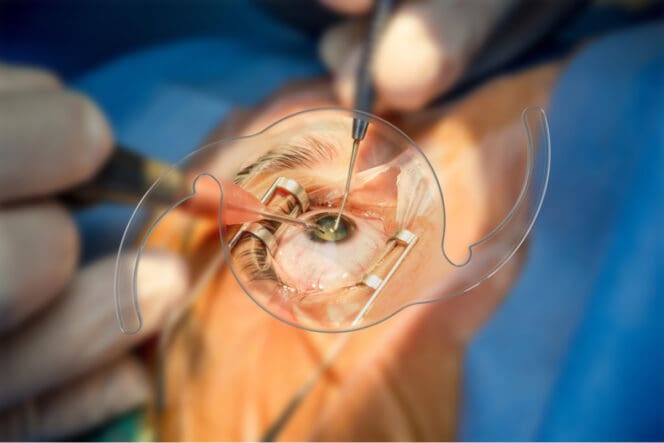A Symfony IOL is an extended depth-of-focus (EDOF) artificial lens that a surgeon inserts into a patient’s eye after cataract removal surgery. EDOF refers to the fact that lens provides a broader, seamless vision range by stretching light that passes through it.

Symfony IOLs are the first lenses of its kind to get approved by the U.S. Food and Drug Administration (FDA). For cataract surgery patients, these lenses are an ideal alternative to monofocal IOLs with just one focusing distance.
The EDOF technology minimizes certain visual side effects experienced with multifocal IOLs.
Types
Abbot, the manufacturer of Symfony lenses, created five models of extended depth-of-focus IOLs. The devices fall into two primary categories — Symfony Extended Range of Vision IOLs and Toric Extended Range of Vision IOLs.
- Extended range of vision IOLs: These IOLs treat presbyopia after cataract removal. They give you sharp distance vision and a better view of up-close or intermediate-distance objects.
- Symfony toric IOLs: These lenses correct presbyopia and astigmatism (the latter is when your cornea has an uneven shape).
What Makes Symfony Lenses Different, and What Are the Benefits?
Symfony IOLs provide these key features to improve your vision quality and range:
- Elongated focus
- Correction of chromatic aberration
- Correction of spherical aberration
Elongated Focus
Multifocal IOLs work by separating light into different points of focus, which can sometimes compromise vision quality. Symphony IOLs address this problem by stretching the focus area instead of splitting images as they enter your eye.
This feature eliminates areas of blurred vision as your eye shifts focus from far to near and in-between distances. Conversely, most monofocal IOLs are set to distance vision, increasing your reliance on near-vision glasses.
Extended vision range after cataract surgery can help with your everyday living in many ways, including:
- You can safely drive a car or enjoy watching your kids play in the backyard (excellent distance vision)
- You can read a book or browse the web on your smartphone (good near vision)
- You can work at your computer (intermediate vision range)
The continuous scope of high-quality vision provided can reduce your dependence on eyeglasses. While you may still need reading glasses after getting a Symfony IOL, the vision range and quality is superior to multifocal and monofocal IOLs.
Correction of Chromatic Aberration
Chromatic aberration is the distortion of color that occurs when light passes through a lens with multiple focus points. Multifocal IOLs have this problem, which results in low-quality images in the eye.
Since Symfony IOLs don’t split light, they eliminate color distortion across supported vision ranges and light conditions.
Correction of Spherical Aberration
Some IOLs cause blurriness around the edge of an image (spherical aberration). Symfony IOLs incorporate special material that corrects for this defect, substantially boosting image quality.
Additionally, the EDOF lenses eliminate several night-vision difficulties associated with some standard IOLs. With the implants, you’re less likely to experience halos or glares in darkness or dim light.
When Are Symfony IOLs Used (Who Is a Candidate?)
When doctors perform cataract surgery, they remove your natural eye lens. Implanting an IOL is the only way to restore your vision in the affected eye.
Your eye doctor may recommend a Symfony EDOF lens after the surgery to correct presbyopia. This implant provides better intermediate and near vision without reducing distance vision acuity.
If you have preoperative astigmatism, consider the toric version of Symfony IOLs. Astigmatism can cause blurry vision.
What to Consider When Choosing the Symfony IOL?
Compared to most alternatives, a Symfony IOL provides better vision quality and range. Before treatment, consider how cataract surgery and IOL implants may impact your eye health and life before.
Important considerations include:
- You may still need near-vision glasses for detailed up-close work
- IOLs and cataract surgery may not correct your vision problems if the affected eye is unhealthy
- Discuss potential side effects with your eye surgeon, such as retinal detachment
Are Symfony IOLs Safe?
The U.S. Food and Drug Administration (FDA) approved Symfony IOLs in 2016 after the lenses went through successful safety assessments. However, both the FDA and the manufacturer shared important precautions and risks, including:
- IOLs are not safe for people with previous eye injury
- Eye bleeding, infection, or inflammation can occur (these incidences are rare)
- Some patients may need their Symfony IOL removed after postoperative complications
- The risk of postoperative complications is higher in diabetic and hypertensive patients
Costs
Costs vary by factors like your location, surgeon, and type of IOL. According one survey of eye surgeons, Symfony presbyopia and astigmatism IOLs cost about $2,590 per eye.
Does Insurance Cover Symfony IOLs?
Medicare and most insurance companies only cover medically necessary lenses. Monofocal IOLs are usually covered because these are the minimum requirement to restore your vision after cataract removal.
Symfony IOLs are premium solutions for astigmatism and presbyopia, so these aren’t typically covered. The main reason for this is that there’s a cheaper way to mitigate the vision effects of these conditions: cataract surgery with a monofocal lens and glasses.
So, if your cataract surgery and Symfony IOL costs exceeded the applicable coverage limit, you’d be on the hook for the extra fees.
References
-
FDA Approves the Tecnis Symfony® Intraocular Lenses, the First and Only Extended Depth of Focus Lenses for People With Cataracts. (July 2016). Abbot.
-
Extended Depth of Focus IOLs. (April 2017). Review of Ophthalmology.
-
FDA Approves First Intraocular Lens With Extended Range of Vision For Cataract Patients. The U.S. Food and Drug Administration. (July 2016).
-
IOL Survey: New Lenses Turn Surgeons’ Heads. (January 2021). Review of Ophthalmology.
-
Presbyopia-Correcting IOLs FAQ. (November 2021). All About Vision.
Last Updated March 1, 2022
Note: This page should not serve as a substitute for professional medical advice from a doctor or specialist. Please review our about page for more information.